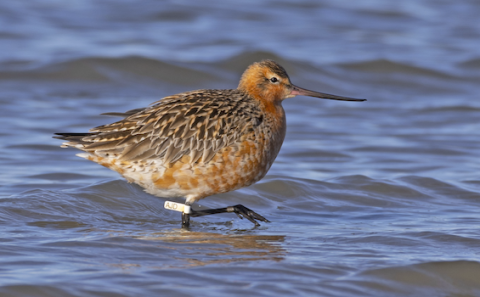
An invisible yet indelible cord connects rivers and estuaries around Aotearoa to Alaska’s Yukon and Kuskokwim Delta, and each year it reverberates with the beating wings of the Kūaka (Bar-tailed Godwit) on their staggering annual migrations.
As Alaskan autumn temperatures cool, Kūaka respond to a silent yet powerful karanga to leave their nesting sites and travel along the 11,000 km cord to Aotearoa. Kūaka fly here to feed on productive estuarine habitats around the motu between October and March. The evolutionary, physiological, and navigational wonder of the Kūaka’s annual migration has captivated researchers from around the world who are working hard to understand them better.
Scientist Dr Billy van Uitregt (Ngā Rauru, Te Ātihaunui-a-Pāpārangi, Tūhoe) and designer/artist Cecelia Kumeroa (Te Ātihaunui-a-Pāpārangi) travelled to Alaska in 2023 to meet with First Nations Alaskans to explore a possible Kūaka research collaboration. They were met with resounding enthusiasm from the Native Village of Paimiut (a Yup’ik community) Tribal Council. Paimiut Yup’ik were already well underway building similar Indigenous collaborations with Australian First Nations communities, and were keen to build an Indigenous global network.
In March this year, Indigenous communities at either end of the Kūaka cord came together and committed to collaborate on caring for our shared manu relations.
The gathering saw a delegation of Paimiut Yup’ik, along with representatives of Australian First Nations communities travel to Aotearoa to wānanga with a Whanganui hapū research group. Hosted at Te Ao Hou marae, the 10 days wānanga explored the connections between landscapes, rivers, and cultural narratives, through Kūaka.
Billy is a zoologist and works as a senior lecturer in geography at Victoria University. He says the project is looking at how Kūaka feature in Whanganui narratives, and the research group are enlivening those narratives and creating new ones to engage their community in the kaupapa.
“Through such narratives, we want people to understand that these manu are a very important tohu. They give us a very clear indication of not only the health of our system locally, but of the health of the global system. If we can embed them through our knowledge practices like composing waiata or whakatauki or through toi Māori, these narratives invoke a real sense of love and care for the manu and that drives us to act on climate change and look after their environment.”
The wānanga was timed around the scheduled migration of one particular Kūaka that spends most of his year on the Whanganui River. ‘AJD’, as he is known, is a male Kūaka that was given a leg tag in 2008 and returns to the Whanganui estuary every year to feed from November to March. AJD is something of a celebrity with local bird enthusiasts, including Paul Gibson penned a book about AJD called Feats beyond amazing: the life story of a bar tailed godwit. In it, he highlights how AJD is a stickler for timing, departing Whanganui each year at around 5pm on March 25, with only minor deviations. However, this year things weren’t quite right for AJD and he left four days late. The winds were against him and it would have been dangerous to use up so much energy battling the wind so early in a long migration. His late departure raises many questions: Will he make it on time to the staging areas? Will he find enough food if he’s late? Is bad weather due to climate change going to make it harder and harder for him to make that long journey?
“This manu forces us to think globally. It’s not just about our backyard, but how the flourishing of this bird is connected to another river in a distant part of the world. The Kūaka tells us that we are all part of nature’s local and global rhythms,” says Billy.
“We’ve done our best to wish AJD well on his journey and will now be focused locally and globally to ensure he and his species are better able to flourish into the future.”
As the global Indigenous collective grows, they’re eager to connect with other local Indigenous initiatives focused on migratory birds. If your community is eager to collaborate or contribute to the collective, get in touch with Billy at billy.vanuitregt@vuw.ac.nz.
The project is funded by the Mātauranga Māori Research Fund at Te Herenga Waka, which aims to grow research partnerships with Māori hapū, iwi, communities, and organisations.